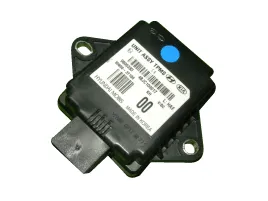Hyundai Genesis (DH): Tire Pressure Monitoring System / TPMS Receiver Description and Operation
Hyundai Genesis (DH) 2013-2016 Service Manual / Suspension System / Tire Pressure Monitoring System / TPMS Receiver Description and Operation
| Description |

| 1. |
Function
The TPMS monitors the pressure and temperature of the tires
and warns the driver of changes that could potentially influence driving
conditions.
The cluster warning lamp displays the messages generated from processing the data.
The ECU processes the data received from the WE sensor,
determines the conditions of the tire, and then sends any necessary
warning signals to the driver through the CAN line or hard wire control
line. |
| 2. |
Mode
|
| Operation |
| 1. |
General Function
|
| 2. |
General Conditions to Learn New Sensors:
|
| 3. |
General Conditions to Un-Learn a sensor that is removed:
|
Removal 1. Remove the valve core and deflate the tire. 2. Remove the side of the tire bead area from the wheel using tire changing machine .
Circuit Diagram 1. Circuit diagram 2. Receiver connector terminals. 3. Receiver connector function. No FunctionDescription1BatteryVBAT2IG ONBattery to IG ON3CAN_HighCAN_High4CAN_LowCAN_Low5GroundBattery to ground6--
Other information:
Hyundai Genesis (DH) 2013-2016 Service Manual: Specifications
S
Hyundai Genesis (DH) 2013-2016 Service Manual: Power Mosfet Repair procedures
Inspection 1. Turn the ignition switch ON. 2. Manually operate the control switch and control the voltage of the blower motor. 3. Select the control switch to raise the voltage until high speed. Specification Fan Speed (Manual)Motor Voltage (V)13.
Categories
- Manuals Home
- Hyundai Genesis Owners Manual
- Hyundai Genesis Service Manual
- General Information
- Engine Control / Fuel System
- Smart Cruise Control Unit Repair procedures
- New on site
- Most important about car
Copyright В© 2026 www.hgenesisdh.com - 0.0355
